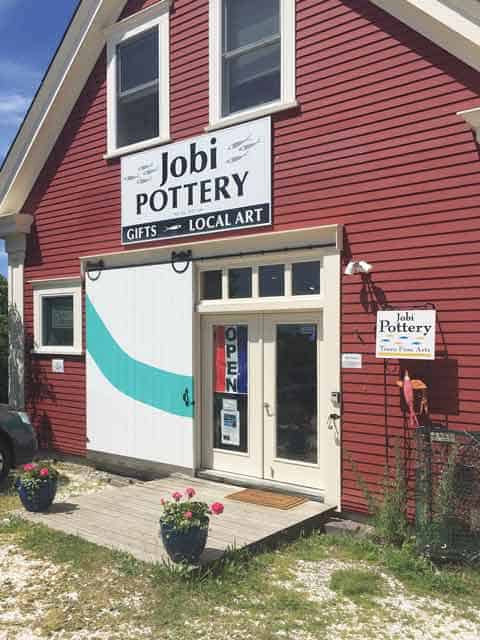Inside the Jobi Pottery Shop at the Highland House.
by Melissa Yeaw
Much of the population of Truro consists of independent-minded creative individuals, a little rugged, sometimes seeming a bit introverted, and basically unconventional. This means they are industrious loners, creative entrepreneurs, thoughtful explorers. Cottage industries prevail here, and one that has been around for 65 years is Jobi Pottery.

In 1952, two men in their twenties came to Truro on a vacation. They stayed at the Highland House Hotel in North Truro. And, like many visitors, they fell in love with the Cape. That winter they met Verna, a woman in upstate New York who was selling her pottery business. They bought all the molds and accessories and in 1953 they returned here for good. Joseph Colliano played the piano, Bill Hastings played the organ. By night they bartended at the Highland House and played four hands on the piano. By day, the couple made pottery. Joe and Bill (known as the Jobis) worked out of an old hot dog shack located next to the lighthouse on the Highland House property, and that summer they completely sold out of the pottery. A legend was born. In the late 60s when the National Seashore took over the land, Jobi Pottery was moved to Moses Way, also in North Truro, and in the late 70s, Bill and Joe sold the business to Elizabeth and Lee Locke. The Lockes operated the business, later employing their son Steve, for 25 years. In 2003, Susan Kurtzman purchased Jobi.

Kurtzman brought it all together, all the science, all the techniques, all the families. Steve Locke trained her on the production, and then when she offered him a job, he stayed. To this day he is still throwing pots at Jobi Pottery. Joe, at age 78, came back and helped her with the designs.
“It’s a Truro cottage industry that has survived. Three families have owned it and it’s still here,” says Kurtzman, proudly. “It hasn’t moved out of this town, not once.” Her son works for her, and Susan keeps it local, employing four people year-round. The shop, located at 314 Route 6 in Truro, next to Highland Road, features mainly the pottery, with twenty-two original designs and at least six new designs in countless color combinations, but you can also find artwork and sculpture, photography, and even greeting cards, all generated in this area. Kurtzman is delighted to support the locals, as she says, “People are in the woods, trying to make a living.”

The pottery itself has a retro feel to it, partly because the designs are basically the same and date back to the 1950s, and partly because the technique is the same, which also dates back to the 1950s. It is all made by hand, from beginning to end. Kurtzman purchases the clay (called “slip” in a liquid form) from the same suppliers Joe and Bill used. Then it is cast in molds created from Bill and Joe’s original molds. Once it sets, Kurtzman or one of her artists uses slip (wet clay) to paint the signature little black minnows (or blueberries, sandpipers, whales, and even lighthouses, to name just a few) into the cast clay (now in its dried form called “greenware”), and then it is fired for the first firing. This one takes 36 hours. The design itself is painted right into the greenware, therefore the image is fired directly into the clay. After the first firing, the clay pot or bisqueware is dipped in a silica-based overglaze and fired again. This step has to be done very carefully, as no piece can touch any other piece and also can’t touch the bottom of the kiln. This firing, including the cooling down, takes 30-32 hours. All told, from start to finish, the whole process takes about three weeks, with many different hands involved. This process is labor intensive, and explains the very distinctive look to the pottery. If you see Jobi Pottery in a shop, you know it is Jobi Pottery.

How does a small business like this one survive 65 years? Lots of factors. First, there’s the history. People return to the Cape, people remember Jobi, people rely on the tradition. Kurtzman relays how grandparents bring their grandchildren and remember the shop at Highland House. People also collect the old designs. Kurtzman took a “very traditional approach,” as did the Lockes. They all “tried to keep the same colors, the same sensibility, the same designs,” according to Kurtzman. “Everything has a story. It’s really interesting to me and it’s interesting to people. It’s what they want to know when they come here. Who made this? Is it local?” That’s another way to survive, keep it local. Kurtzman carries wooden oyster clamps made by retired Truro police officer Barry Meegan, honey from Longnook Meadow Farm in Truro, whale tails by local Tom MacKuen, and lots of artwork by Cape artists. Finally, she keeps it fresh. Elizabeth Locke added a few designs, as did Kurtzman. She test-markets in her own shop, and encourages her store manager and son to create new designs. Jobi Pottery has that tough, creative spirit of Truro, and of Cape Cod. It’s a cottage industry that lives on.

Jobi Pottery is located at 314 Rte. 6 in Truro. In Provincetown, some of their work can be found at the Pilgrim Monument and Provincetown Museum gift shop, the Province Lands Visitor Center, Impulse Art Gallery (188 Commercial Street), the Salt Pond Visitors Center in Eastham, and throughout the Cape at various galleries and gift shops. For more information call 508.349.2303 or visit jobipottery.com.











